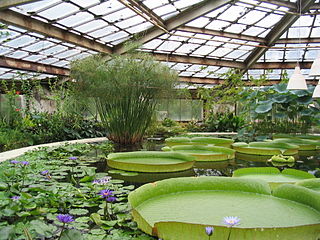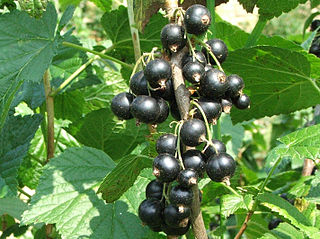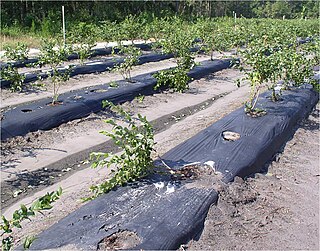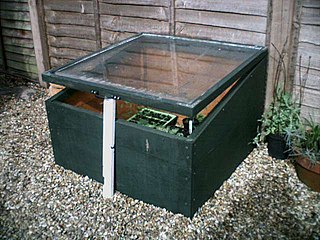
A greenhouse is a special structure that is designed to regulate the temperature and humidity of the environment inside. There are different types of greenhouses, but they all have large areas covered with transparent materials that capture sunlight and heat. The most common materials used in modern greenhouses for walls and roofs are rigid plastic made of polycarbonate, plastic film made of polyethylene, or glass panes. When the inside of a greenhouse is exposed to sunlight, the temperature increases, providing a sheltered environment for plants to grow even in cold weather.

The blackcurrant, also known as black currant or cassis, is a deciduous shrub in the family Grossulariaceae grown for its edible berries. It is native to temperate parts of central and northern Europe and northern Asia, where it prefers damp fertile soils. It is widely cultivated both commercially and domestically.

Horticulture is the art and science of growing plants. This definition is seen in its etymology, which is derived from the Latin words hortus, which means "garden" and cultura which means "to cultivate". It is important to note that there are various divisions of horticulture because plants are grown for a variety of reasons. In anthropology, horticulture refers to a subsistence strategy characterized by the small-scale, non-industrial cultivation of plants for food. Horticulture is typically small-scale or ornamental, as compared to the larger-scale cultivation of crops that is seen in agriculture. However, there are aspects of horticulture that are industrialized/commercial such as greenhouse production across the globe.
Season extension in agriculture is any method that allows a crop to be grown beyond its normal outdoor growing season and harvesting time frame, or the extra time thus achieved. To extend the growing season into the colder months, one can use unheated techniques such as floating row covers, low tunnels, caterpillar tunnels, or hoophouses. However, even if colder temperatures are mitigated, most crops will stop growing when the days become shorter than 10 hours, and resume after winter as the daylight increases above 10 hours. A hothouse — a greenhouse which is heated and illuminated — creates an environment where plants are fooled into thinking it is their normal growing season. Though this is a form of season extension for the grower, it is not the usual meaning of the term.

A mulch is a layer of material applied to the surface of soil. Reasons for applying mulch include conservation of soil moisture, improving fertility and health of the soil, reducing weed growth, and enhancing the visual appeal of the area.

In agriculture, polyculture is the practice of growing more than one crop species together in the same place at the same time, in contrast to monoculture, which had become the dominant approach in developed countries by 1950. Traditional examples include the intercropping of the Three Sisters, namely maize, beans, and squashes, by indigenous peoples of Central and North America, the rice-fish systems of Asia, and the complex mixed cropping systems of Nigeria.

Plastic mulch is a product used in plasticulture in a similar fashion to mulch, to suppress weeds and conserve water in crop production and landscaping. Certain plastic mulches also act as a barrier to keep methyl bromide, both a powerful fumigant and ozone depleter, in the soil. Crops grow through slits or holes in thin plastic sheeting. Plastic mulch is often used in conjunction with drip irrigation. Some research has been done using different colors of mulch to affect crop growth. Use of plastic mulch is predominant in large-scale vegetable growing, with millions of acres cultivated under plastic mulch worldwide each year.

A polytunnel is a tunnel typically made from steel and covered in polyethylene, usually semi-circular, square or elongated in shape. The interior heats up because incoming solar radiation from the sun warms plants, soil, and other things inside the building faster than heat can escape the structure. Air warmed by the heat from hot interior surfaces is retained in the building by the roof and wall. Temperature, humidity and ventilation can be controlled by equipment fixed in the polytunnel or by manual opening and closing of vents. Polytunnels are mainly used in temperate regions in similar ways to glass greenhouses and row covers. Besides the passive solar heating that every polytunnel provides, every variation of auxiliary heating is represented in current practice. The nesting of row covers and low tunnels inside high tunnels is also common.

In agriculture and gardening, a cold frame is a transparent-roofed enclosure, built low to the ground, used to protect plants from adverse weather, primarily excessive cold or wet. The transparent top admits sunlight and prevents heat escape via convection that would otherwise occur, particularly at night. Essentially, a cold frame functions as a miniature greenhouse to extend the growing season.

Organic horticulture is the science and art of growing fruits, vegetables, flowers, or ornamental plants by following the essential principles of organic agriculture in soil building and conservation, pest management, and heirloom variety preservation.

The silverleaf whitefly is one of several species of whitefly that are currently important agricultural pests. A review in 2011 concluded that the silverleaf whitefly is actually a species complex containing at least 40 morphologically indistinguishable species.

In agriculture, a living mulch is a cover crop interplanted or undersown with a main crop, and intended to serve the purposes of a mulch, such as weed suppression and regulation of soil temperature. Living mulches grow for a long time with the main crops, whereas cover crops are incorporated into the soil or killed with herbicides.

Worldwide more human beings gain their livelihood from agriculture than any other endeavor; the majority are self-employed subsistence farmers living in the tropics. While growing food for local consumption is the core of tropical agriculture, cash crops are also included in the definition.

The carrot fly is a pest of gardens and farms, and mainly affects the crop of carrots, but can also attack parsnips, parsley and celery. It is a member of the family Psilidae.

A beneficial weed can be an invasive plant that has some companion plant effect, is edible, contributes to soil health, adds ornamental value, or is otherwise beneficial. These plants are normally not domesticated. However, some invasive plants, such as dandelions, are commercially cultivated, in addition to growing in the wild. Beneficial weeds include many wildflowers, as well as other weeds that are commonly removed or poisoned. Certain weeds that have obnoxious and destructive qualities have been shown to fight illness and are thus used in medicine. For example, Parthenium hysterophorus, native to northern Mexico and parts of the US, has been an issue for years due to its toxicity and ability to spread rapidly. In the past few decades, though, research has found that P. hysterophorus was "used in traditional medicine to treat inflammation, pain, fever, and diseases like malaria dysentery." It is also known to create biogas that can be used as a bioremediation agent to break down heavy metals and other pollutants.

Plasticulture is the practice of using plastic materials in agricultural applications. The plastic materials themselves are often and broadly referred to as "ag plastics". Plasticulture ag plastics include soil fumigation film, irrigation drip tape/tubing, plastic plant packaging cord, nursery pots and bales, but the term is most often used to describe all kinds of plastic plant/soil coverings. Such coverings range from plastic mulch film, row coverings, high and low tunnels (polytunnels), to plastic greenhouses.
Soil solarization is a non-chemical environmentally friendly method for controlling pests using solar power to increase the soil temperature to levels at which many soil-borne plant pathogens will be killed or greatly weakened. Soil solarization is used in warm climates on a relatively small scale in gardens and organic farms. Soil solarization weakens and kills fungi, bacteria, nematodes, and insect and mite pests along with weeds in the soil by mulching the soil and covering it with a tarp, usually with a transparent polyethylene cover to trap solar energy. This energy causes physical, chemical, and biological changes in the soil community. Soil solarization is dependent upon time, temperature, and soil moisture. It may also be described as methods of decontaminating soil or creating suppressive soils by the use of sunlight.

Horticultural fleece is a thin, nonwoven, polypropylene fabric which is used as a floating mulch to protect both late and early crops and delicate plants from cold weather and frost, as well as insect pests during the normal growing season. It admits light, air, and rain but creates a microclimate around the developing plants, allowing them to grow faster than the unprotected crops.
Sustainable landscaping is a modern type of gardening or landscaping that takes the environmental issue of sustainability into account. According to Loehrlein in 2009 this includes design, construction and management of residential and commercial gardens and incorporates organic lawn management and organic gardening techniques.
This glossary of agriculture is a list of definitions of terms and concepts used in agriculture, its sub-disciplines, and related fields, including horticulture, animal husbandry, agribusiness, and agricultural policy. For other glossaries relevant to agricultural science, see Glossary of biology, Glossary of ecology, Glossary of environmental science, and Glossary of botanical terms.


















